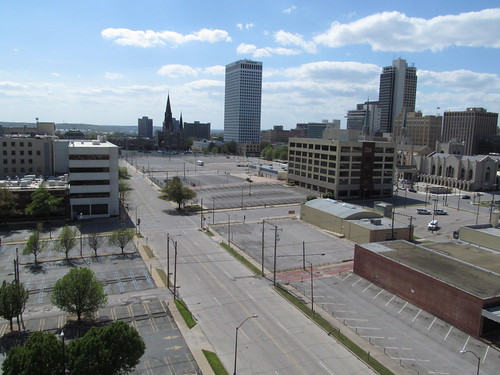Tulsa Downtown: September 2013 Archives

Route 66 "planter" and "nature band-aid" attempt to distract from ugliness of Tulsa Community College surface parking lot.
UPDATE 2019/11/29: I'm revisiting this entry years later, as Strong Towns uses Black Friday to call attention to parking minimums, zoning laws that require a minimum number of parking spaces based on square footage and property use, far in excess of actual usage. See the end of this entry for links and video of TMAPC and City Council action to kill this proposal.
This afternoon, Wednesday, September 18, 2013, the Tulsa Metropolitan Area Planning Commission will consider a proposed change to the zoning code intended to discourage the demolition of downtown buildings for surface parking.
Here is a link to a PDF of the draft zoning code amendment regarding downtown Tulsa demolition.
The proposal is long-overdue, and the TMAPC should allow it to move forward to the City Council for consideration.
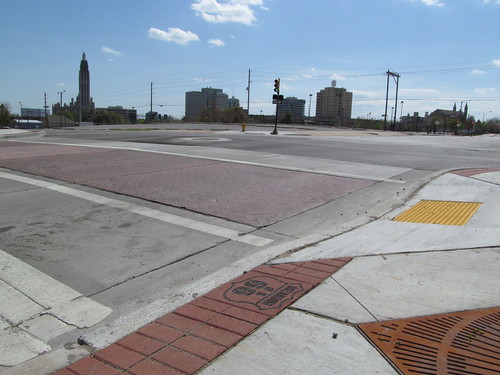
Looking southwest across the parking crater, from 10th and Detroit. Fancy Route 66 streetscaping doesn't make up for the desolation of block after empty block of surface parking.
Along with it should be the removal of financial and regulatory incentives for demolition and obstacles to adaptive reuse. The downtown assessment, which is a flat rate per square foot of building and land, allows a property owner to give himself an instant tax cut with a bulldozer. The owner of the old Page Dairy at 7th and Frankfort did just that in July 2009. Regulations requiring old apartment buildings to retrofit with state-of-the-art fire protection features are another burden on creative building reuse, increasing the likelihood of another demolition of what had been affordable downtown housing.
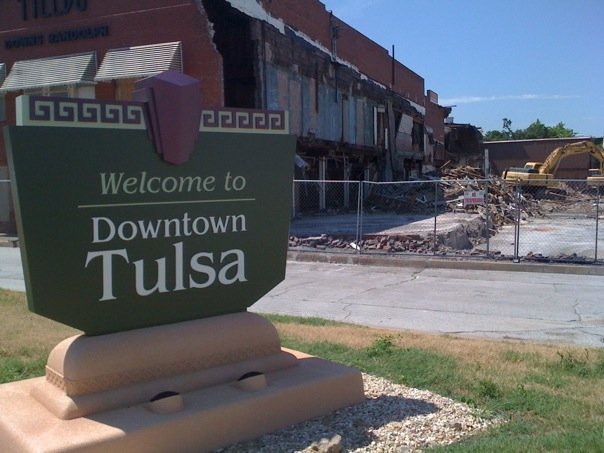
Page Glencliff Dairy (Fields Downs Randolph building) being demolished in 2009. Photo by Daniel Hickman.
Earlier this year, Tulsa won Streetsblog's national competition for worst "parking crater," the vast asphalt wasteland that stretches with few interruptions across the south end of downtown and reaches up along the east fringe. As hoped, the national attention has bolstered the effort to address the problem which began last July with a temporary moratorium.
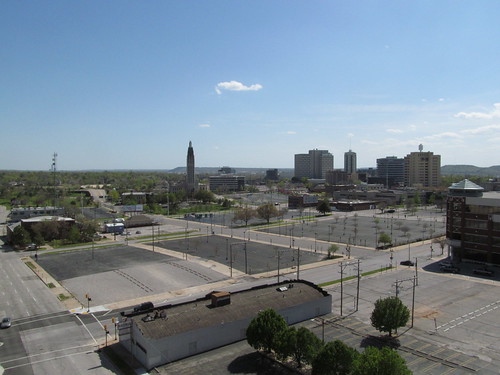
Tulsa Community College, Boston Avenue Methodist Church, and First Methodist Church's contributions to Tulsa's parking crater. Near 10th and Detroit looking south.
And it is a problem. A downtown doesn't work the way a downtown should, it doesn't work as a lively urban district, if there are vast voids between clusters of buildings. Surface parking is an inhospitable environment for someone on foot. When you're walking down a street with parking on both sides, there's no place to go if the weather turns, no one around to help if there's an emergency, nothing to keep you interested.
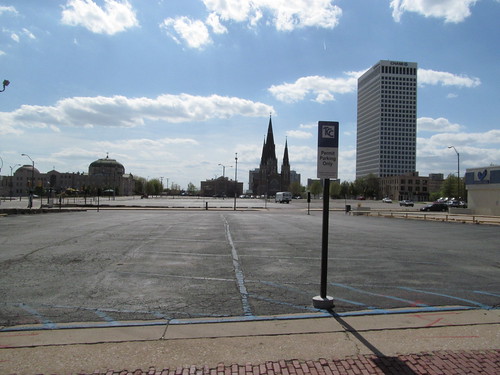
Looking west across the parking crater from Cincinnati between 8th and 9th toward 1st Christian Church and Holy Family Cathedral. Tulsa Community College lot is in the foreground.
I remember a 1996 visit from a college friend. He and a colleague came from Massachusetts to Tulsa that July to man a booth at the American Council of the Blind annual convention. Because they were staying downtown at the Doubletree, they didn't bother to rent a car. What a mistake! The first night in town they set off east on 7th Street in search of dinner, thinking that surely they'd find something downtown. Instead, they found a whole lot of nothing -- empty lots and closed office buildings. The view wouldn't be much different today.
What life we have downtown, we owe to building owners like David Sharp who chose to buy and hold on to modest, usually unremarkable older buildings in the Blue Dome and Bob Wills Districts as one building after another were taken for parking.
Why do old buildings matter? Here's an explanation from my June 7, 2006, column on the legacy of urban journalist Jane Jacobs:
[Jacobs wrote]: "Cities need old buildings so badly it is probably impossible for vigorous streets and districts to grow without them. By old buildings I mean not museum-piece old buildings... but also a good lot of plain, ordinary, low-value old buildings, including some rundown old buildings."Think about the most lively and interesting places in Tulsa, the kind of places you'd take a visitor for a night on the town: Brookside, the Blue Dome District, Brady Village, Cherry Street, 18th and Boston. Each of those districts had an abundance of old buildings, buildings that are for the most part unremarkable. But those buildings provided an inexpensive place for someone with a dream to start a new business.
You might have seen the same kind of vitality develop in the south part of downtown, with business springing up to serve the tens of thousands who attend classes at TCC's Metro Campus or participate in activities at the downtown churches, but so many of the buildings have been taken for parking by the churches and by TCC that a prospective business owner would be hard-pressed to find a location.
"As for really new ideas of any kind - no matter how ultimately profitable or otherwise successful some of them might prove to be - there is no leeway for such chancy trial, error and experimentation in the high-overhead economy of new construction. Old ideas can sometimes use new buildings. New ideas must use old buildings."
Nearly all of downtown is under a special zoning classification (Central Business District, CBD) which, unlike every other part of the city, has no minimum parking requirements for businesses. But the other factors have encouraged demolition for parking: The costs of bringing an old building up to code, demand for office parking during downtown's late '70s, early '80s boom (roughly 70,000 downtown employees), Tulsa Community College's land-banking (buy a building, level it for student parking), reserve it for future development), and Sunday morning demand driven by our unusually healthy downtown churches.
Way back in 1998, the first time I ran for City Council, I proposed a demolition moratorium and a downtown parking summit. Since offices, churches, and TCC all generated parking demand at different times, it seemed like it should be possible to accommodate everyone's needs without dismantling more of what little remains of our urban fabric.
As bad as downtown already was, it was getting worse. Around that time, the Catholic Diocese of Tulsa demolished the Tulsa Apartments at 9th and Main (a pair of four-story brick buildings from the 1920s) and the old Cathey's Furniture showroom along the west side of Main between 8th and 9th. A diocesan spokesman told me at the time that the intention was to build a new chancery building and a grand plaza with the cathedral as backdrop. Instead, they simply tore down the buildings, paved the lot, and striped it for parking, as it remains today.
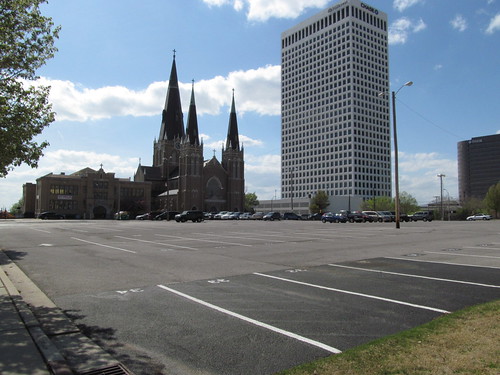
Site of Tulsa Apartments and Cathey's Furniture, 9th and Main, demolished in 1998 by the Catholic Diocese of Tulsa; now surface parking
When downtown leaders began the process of reopening the Main Mall to vehicular traffic, I urged that the city get commitments from adjoining property owners not to demolish their buildings for parking. If the point of reopening the mall was to allow businesses along Main to flourish, tearing down the few remaining buildings would defeat the purpose. Not long after, Arvest Bank demolished three older two-story buildings on the west side of Main north of 6th Street. A few years later, the Tulsa World demolished the old Froug's Department Store on the southwest corner of 3rd and Main for an air conditioning plant, and then Kanbar Properties tore down two single-story retail buildings just north of 5th on the east side of Main.
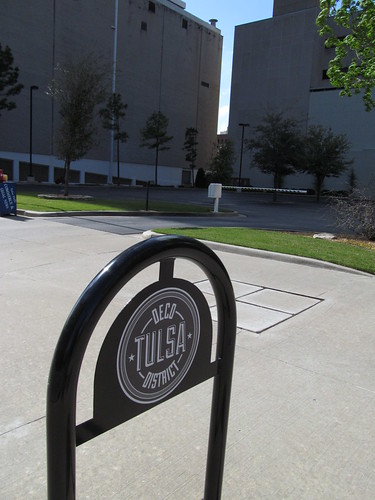
Tulsa Deco District sign decorates Arvest Bank parking lot. The three early 20th century Plains Commercial buildings on this site were pulled down by Arvest in the early 2000s.
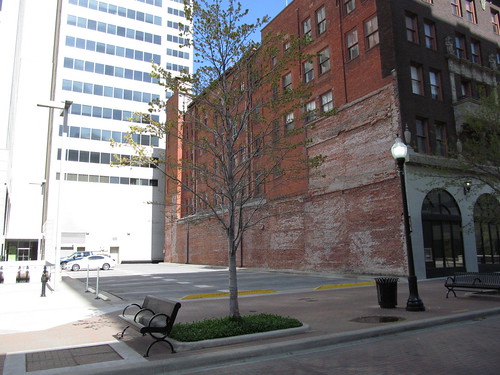
Site of the Lerner Shops building (once the first home to KGCT-TV 41) and another building that were purchased and then demolished by Kanbar Properties.
In 2006, vocal downtown office building owners, who seemed to see downtown as nothing more than an office park, blocked a set of modest downtown preservation measures called the CORE recommendations from even moving out of the recommendation stage. Susan Neal, an advisor to then-Mayor Kathy Taylor on development issues, played a significant role in obstructing progress on the issue, presumably with the knowledge and approval of her boss.
The recommendations were modest and appropriate, but it took five years before they began to become a reality:
- Review all downtown buildings.
- Be proactive in meeting parking demand with structured parking, and discourage surface parking.
- Make downtown preservation a key component of Tulsa's new comprehensive plan.
- Create and promote incentives for redevelopment.
- Create a demolition review panel, to be designated by the Preservation Commission, that could halt demolition of a significant building for up to four months.
Plenty of our peer cities in the region, large and small, have put limits on demolition in the interest of historic preservation. Some have managed to combine historic preservation and parking. In Abilene, Texas, we noticed a number of hundred-year-old one-story buildings that had been opened up for parking. The structure is intact, ready for restoration to a more lucrative use.
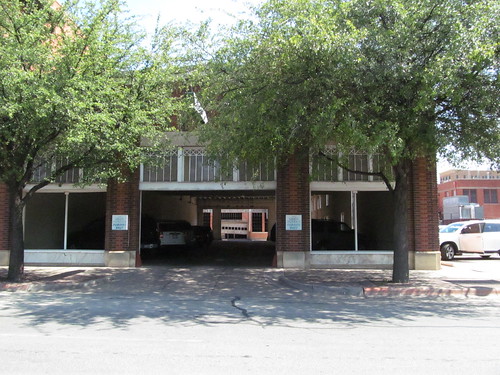
 Old buildings in downtown Abilene, Texas, converted to covered parking, preserving them for some future use.
Old buildings in downtown Abilene, Texas, converted to covered parking, preserving them for some future use.That's been done in Tulsa, too, although it's not as visible. For many years the bottom floor of the old Renberg's building on Main has been used as parking, with access from the alley east of Main. When the Snyder family began to restore the Mayo Hotel, their first step was to convert the basement for parking, generating revenue that was later used to turn the first two floors into a space that could be rented for wedding receptions and other special events.
I urge the TMAPC to allow the proposal to move forward to the City Council. I urge the Tulsa City Council to approve limits on downtown demolition and to provide relief from regulatory and financial burdens that create incentives for demolition rather than reuse.
TAKE ACTION:
You can attend and speak at the TMAPC hearing, which begins at 1:30 pm today in the Tulsa City Council chambers on the 2nd (ground) floor of City Hall. Enter at 2nd and Cincinnati. The item is fairly early in the agenda, after a series of lot splits (usually routinely approved) and some "housekeeping" amendments to the Comprehensive Plan. (Most of those "housekeeping" amendments involve fixing errors in Comprehensive Plan designations, a couple involve patching the plan to reflect zoning decisions made out of accord with the plan, but one would involve commercial intrusion into a neighborhood on the west side of 2nd and Memorial. There's also a proposal to include more legible, large-format maps as part of the printed version of the Comprehensive Plan.)
You can also register your opinions on the City of Tulsa Planning Department's FeedBack site, which has a page devoted to the proposed downtown demolition ordinance. This is treated as official feedback, and you are required, as you would be at a public hearing, to register with your real name and address. (Your address is kept confidential, but you will be identified on the site by name and council district.)
MORE:
Tulsa's progress through the Streetsblog "Parking Madness" competition for America's worst parking crater:
Sweet 16: Tulsa vs. Philadelphia: Tulsa won 95% to 5%. (Philadelphia crater had actually been redeveloped by the time of the contest.)
Elite Eight: Tulsa vs. Cleveland: Tulsa won 77% to 23%.
Final Four: Tulsa vs. Houston: Tulsa won 60% to 40%.
Championship: Tulsa vs. Milwaukee: Tulsa won 82% to 18%.
Streetsblog's report on how Denver repaired its parking crater:
In the 1990s, in response to the creeping cancer of surface parking, the Mile High City took action. The city changed its downtown zoning to eliminate surface parking as a use by right. So if you owned a building, you were welcome to tear it down, but you couldn't park cars on the lot. All existing parking lots were grandfathered in.
A relevant quote from a renowned urban planner:
"Actually, there is a point at which a city can satisfy its parking needs. This situation can be found in many small, older American cities and is almost always the result of the same history: at mid-century, with automobile ownership on the rise, a charming old downtown with a wonderful pedestrian realm finds itself in need of more parking spaces. It tears down a few historic buildings and replaces them with surface parking lots, making the downtown both easier to park in and less pleasant to walk through. As more people drive, it tears down a few more buildings, with the same result. Eventually, what remains of the old downtown becomes unpleasant enough to undermine the desire to visit, and the demand for parking is easily satisfied by the supply. This phenomenon could be called the Pensacola Parking Syndrome, in honor of one of its victims."
-- Andres Duany, Suburban Nation, p. 162 [footnote]
UPDATE:
On September 18, 2013, the TMAPC voted 10-1 to recommend against adoption of the proposed downtown demolition and surface parking ordinance. Bill Leighty was the sole commissioner to support the ordinance. His motion to continue the item for 60 days to allow for further public input and amendment was shut down by an 8-3 vote (Mark Liotta and Dwain Midget voted with Bill Leighty in favor). The TMAPC discussion on the ordinance and all comments filed in favor and against can be found in the backup material provided to the City Council.
On October 17, 2013, the Urban and Economic Development Committee of the Tulsa City Council took up the TMAPC's anti-recommendation. Because the TMAPC took action, the City Council had the power to take up the proposed ordinance and approve it, despite the TMAPC's opposition. No action on this item was recorded in the minutes, but video of the meeting reveals that committee chairman Blake Ewing proposed taking no action on the ordinance whatsoever; councilors G. T. Bynum and Phil Lakin spoke in agreement with Ewing. No vote was taken. There was vague talk of a council task force to try to find consensus and then maybe another attempt in the spring. I can't find any trace of this task force being formed. The proposed ordinance was killed for lack of action by the council committee. Jack Fothergill from the City Attorney's office informed the committee that any councilor could put the item on the council's agenda; evidently none ever did.
Here is video of the October 17, 2013, Tulsa City Council Urban and Economic Development Committee meeting. It uses Windows Media Player codecs, and you will need the Silverlight browser extension to watch it; you might have better luck watching it in Internet Explorer or Microsoft Edge.
And here is video of the September 18, 2013, TMAPC hearing, which runs two hours:
Researcher's note: Sometime in 2017, the city switched to a different provider for online video. The archive of the previous provider (Granicus) is still online, but there is no index for finding the video for a specific meeting. I used a search engine to find video for one 2013 meeting, then tried different values for the clip_id parameter in the URL, going up by 100, finding the right range of dates, then narrowing down to find the exact meeting.
